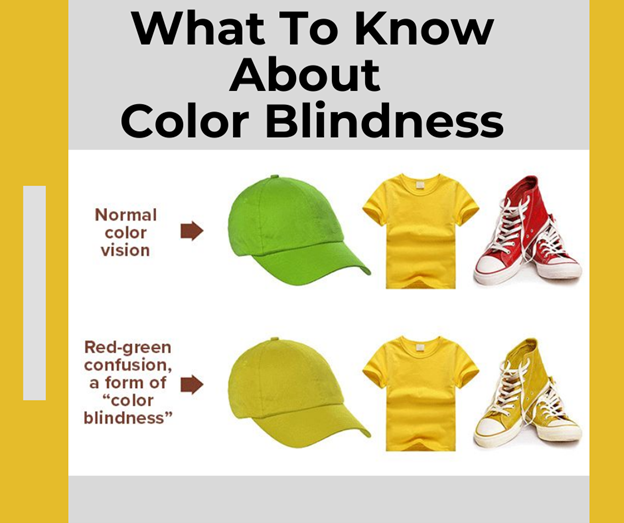
Color blindness happens when you cannot see colors correctly, also known as color deficiency. Color blindness occurs when someone is unable to distinguish between specific colors. Color Blindness usually happens between greens and reds and occasionally blues.
According to the American Academy of Ophthalmology, two types of cells detect light in the retina. The Rods detect only light and dark, which are very sensitive to low light levels. On the other hand, the cone cells detect color and are concentrated near the center of your vision. There are three types of variances of seeing color. The cones see colors: red, green, and blue. The brain begins to interpret and uses input from these cone cells to determine our color perception.
What Are the Different Degrees of Color Blindness?
There are different degrees of color blindness. Some people with mild color deficiencies can see colors usually in good light but have difficulty in dim light. In contrast, others cannot distinguish specific colors in any form of light. The most severe degree of color blindness is when all the surroundings are seen in gray shades, which is uncommon. Color blindness primarily affects both eyes equally and remains stable throughout life.
What Are the Symptoms of Color Blindness?
The symptoms of color blindness range from mild to severe, and many people are unaware they have a color deficiency with mild symptoms. According to the American Academy of Ophthalmology, the symptoms may include:
- Not seeing the full effect of the colors’ hue and brightness
- Unable to distinguish between shades of colors, which happens mainly with reds and greens or blues and yellow hues.
A very rare condition called achromatopsia is when there is an inability to see any color and see only the shades of gray.
What Are the Causes of Color Blindness?
Most people diagnosed with color blindness are born with it, and the defect is usually passed on from a mother to her son. However, other problems that occur later in life result from trauma to the eye, disease, toxic effects from drugs, metabolic disease, or vascular disease.
Who Is at Risk for Color Blindness?
Men have a much higher risk of being born with color blindness than women. There is an estimated 1 in 10 males who have some form of color deficiency. Also, certain conditions such as glaucoma, macular degeneration, diabetes, sickle cell anemia, chronic alcoholism, Alzheimer’s disease, and Parkinson’s disease may increase the risk of acquiring color deficiency.
Diagnosis and Treatment for Color Blindness
Your eye doctor can conduct a test to determine if you have color blindness. There is no treatment for color blindness; however, special glasses and contact lenses may help. We are here to help address the underlying condition, support, and provide the best options for your eye care!

References: American Academy of Ophthalmology and the American Optometric Association. This blog provides information and discussion about eye health and related subjects. The content provided within this blog and any linked materials are not intended and should not be considered medical advice. If the reader or any person has a medical concern, they should consult with an appropriately licensed physician.
